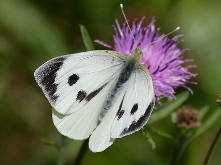The Cabbage White Butterfly (Pieris rapae) is very common and can be found in central Canada and the United States into northwest Mexico.
Adults are typically white with a black tip on the forewing. Females have 2 sub-marginal black spots whereas males have one. The undersides of the hindwings and forewings are usually greenish yellow or greenish gray.

These butterflies can be found in almost any open space in cities and suburbs. They are some of the first butterflies one sees in the spring and can continue into the fall. They are quite prolific with three to five generations per year.
Eggs are cream colored and oblong. They can be found on the underside of leaves in the Brassicaceae or cabbage family. The eggs hatch in four to eight days and larvae/caterpillars mature in two to three weeks depending on temperature. The larvae or caterpillars are green with a yellow dorsal stripe and a row of yellow spots running along the side of the body. They pupate on the host plant with the adult emerging in one to two weeks.

The caterpillars feed on cabbage family plants, especially broccoli, brussel sprouts, cabbage and cauliflower, and they may also feed on plants that contain mustard oils. They make round holes in the leaves and bore into the center of these plants when the heads develop. The adult butterflies feed on nectar from a wide variety of plants including dandelions and clover.
To protect your cabbage crops, install floating row covers to prevent adult moths/butterflies from laying eggs on plants. Monitor your plants weekly. Some people believe that interplanting strongly scented herbs such as lavender will discourage these butterflies.
The use of Bacillius thuringiensis (Bt), a non-toxic, biological insecticide, specifically targets caterpillars, and is effective. It’s also safe and can be used on most garden vegetables. Another option is neem oil which is also safe to use and will not affect beneficial insects.
Article by Lynn Keller, DVM